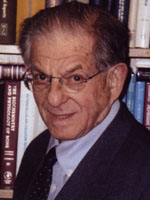
Felix Bronner
University of Connecticut Health Center
The Meeting for "Boneheads"
The first conference on metabolic interrelations, sponsored by the Josiah Macy, Jr., Foundation, took place in February 1949 in New York. Frank Fremont-Smith, the foundation’s medical director, had realized that “the continued isolation of the several branches of science one from another is a serious obstacle to scientific progress” and that a multidisciplinary approach is particularly important for medicine. From the inception of the first conference calcium and bone were emphasized; by the fifth and last conference the topics covered dealt exclusively with the chemistry, physiology, pathology, and metabolism of bone and bone-related substances, and “with special reference to calcium” was rightly added to its title. As might be expected, the conferees were largely senior professors and investigators who often referred to work done by students, fellows, and junior colleagues.
In 1953, at the International Congress of Physiology, where I gave my first paper on the calcium metabolism of adolescent boys (which had also been the subject of my doctoral thesis at the Massachusetts Institute of Technology), I met William Neuman and Harold Copp, both of whom were my seniors. All three of us bemoaned the end of the Macy Conferences. I suggested the organization of a Gordon Conference on the subject and proposed that young investigators should also be able to participate. I was charged with writing to the American Association for the Advancement of Science to propose the conference.
My letter remained unanswered until near Christmastime, when I received a telephone call from GRC director George Parks, asking me to chair a conference on calcium. At that time I was still a postdoctoral fellow at MIT with Robert Harris, who had been my thesis adviser. Surprised but delighted, I asked Bill Neuman and Reidar Sognnaes (at that time at Harvard Dental School, and later dental dean at the University of California at Los Angeles) to join me in forming an organizing committee. I chaired the first Chemistry, Physiology, and Structure of Bones and Teeth Gordon Conference in 1954, with Neuman and Sognnaes as cochairmen (Copp was in Vancouver, Canada, and felt he was too far away to assist in the organization), and Neuman, Sognnaes, and Copp chaired the conference in 1955, 1956, and 1957, respectively.
From the beginning the Bones and Teeth Gordon Conference was an important scientific event: at that time it was the only meeting point for “boneheads” that was distinguished by cutting-edge reports. Moreover, the still-standing GRC policy that forbids publication of the meeting contributed significantly to the openness and collegiality of the conference. For thirty-two years, from 1954 to 1986, the Bones and Teeth Conference met annually at Kimball Union Academy in Meriden, New Hampshire, with maximum attendance (by mostly academics, with industry attendees constituting a small minority). Conferees have come away with ideas for further work, collaborations, and friendships. The conference has also stimulated the formation of many societies and other conferences, including the European and Israeli symposia on calcified tissues; conferences on parathyroid hormone, calcitonin, and vitamin D; and such societies as the American Society for Bone and Mineral Research, the International Bone and Mineral Society, the European Calcium Society, among others. Despite the various opportunities worldwide for meeting with colleagues and sharing knowledge on bone and calcified tissues, the Bones and Teeth Gordon Conference (called Cell and Molecular Biology of Bones and Teeth from 1997 to 2001) continues to meet in alternate years, attracting researchers from around the globe.